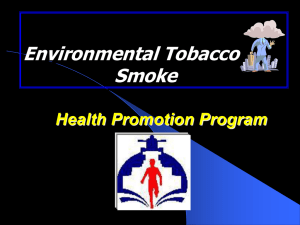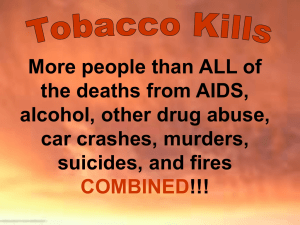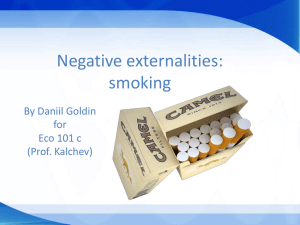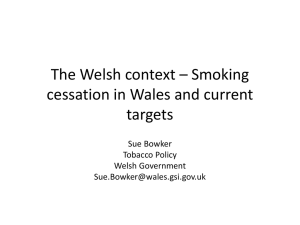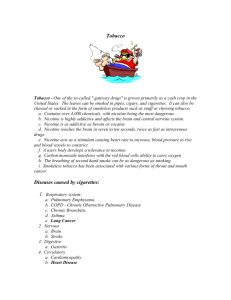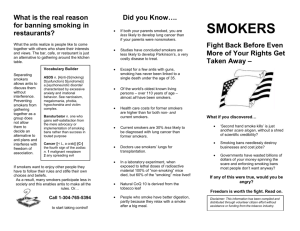SMOKING AND ACADEMIC ACHIEVEMENT
advertisement
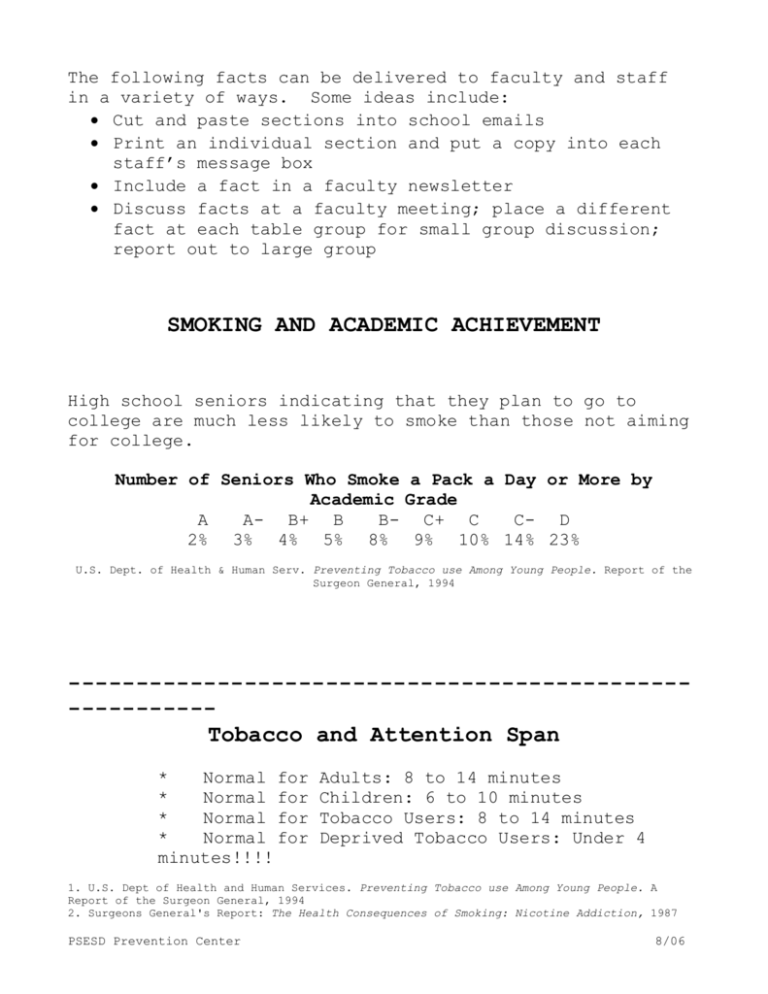
The following facts can be delivered to faculty and staff in a variety of ways. Some ideas include: Cut and paste sections into school emails Print an individual section and put a copy into each staff’s message box Include a fact in a faculty newsletter Discuss facts at a faculty meeting; place a different fact at each table group for small group discussion; report out to large group SMOKING AND ACADEMIC ACHIEVEMENT High school seniors indicating that they plan to go to college are much less likely to smoke than those not aiming for college. Number of Seniors Who Smoke a Pack a Day or More by Academic Grade A A- B+ B B- C+ C C- D 2% 3% 4% 5% 8% 9% 10% 14% 23% U.S. Dept. of Health & Human Serv. Preventing Tobacco use Among Young People. Report of the Surgeon General, 1994 -------------------------------------------------------Tobacco and Attention Span * Normal for * Normal for * Normal for * Normal for minutes!!!! Adults: 8 to 14 minutes Children: 6 to 10 minutes Tobacco Users: 8 to 14 minutes Deprived Tobacco Users: Under 4 1. U.S. Dept of Health and Human Services. Preventing Tobacco use Among Young People. A Report of the Surgeon General, 1994 2. Surgeons General's Report: The Health Consequences of Smoking: Nicotine Addiction, 1987 PSESD Prevention Center 8/06 -------------------------------------------------------- SMOKING AND ACADEMIC ACHIEVEMENT Many physical changes occur in the brain and body as a result of tobacco abuse. These physical changes can make learning and concentration more difficult and can negatively affect school performance. According to the U.S. Department of Health and Human Services (1988) some short-term effects of tobacco use that can impede student performance include: 1. Decreased attentiveness and activity, caused by the effects of nicotine withdrawal 2. Increased absenteeism associated with cold, bronchitis, and asthma due to weakened immune systems. ~~~~~~~~~~~~~~~~~~~~~~~~~~~~~~~ Smoking and Academic Performance in the State of Washington Smoking is strongly correlated with academic performance. Youth who earn better grades are less likely to smoke. The Washington State Healthy Youth Survey, conducted by the Department of Health, OSPI, Department of Social and Health Services and Office of Community Development surveyed nearly 140,000 students in 752 schools statewide in October of 2002. The survey found that among 8th grade students who received most D or F grades, 23.7% were smokers. Among the C students, 13.9 were smokers. 8.2% of students reporting mostly B grades were smokers and among the A students, 3.9% were smokers. PSESD Prevention Center 8/06 ~~~~~~~~~~~~~~~~~~~~~~~~~~~~~~~ Tobacco Use and Academic Achievement A 2000 study in Nicotine and Tobacco Research reported that more than 40% of male smokers were suspended or dropped out of school. The 1998 National survey of American Attitudes on Substance Abuse IV found that 32% of smokers report doing no homework after school compared to 8% of non-smokers. A Yale study conducted in 2004 compared adolescent daily smokers with non-smokers and found those who smoked tobacco experienced impaired cognitive functions, including memory. Smoking teens had difficulty keeping information in mind and manipulating information. They also found impairment with verbal learning and with the ability to pay attention. Smoking Causes Memory and Cognitive Impairment in Adolescents, Biological Psychiatry, Vol. 57; pp 56-66 (January, 2005) ^^^^^^^^^^^^^^^^^^^^^^^^^^^^^^^^^^^^^^ ^^^^^^^^ Study links kid’s lower test scores to secondhand smoke! Children exposed to secondhand smoke have lower test scores in reading, math and problem-solving. In a study of nearly 4,400 students, researchers found that those subjected to the least amount of smoke scored an average of 7 points higher in standardized math and reading tests, compared with children exposed to high levels. Children with the lowest exposure also fared better on two kinds of widely used reasoning tests. PSESD Prevention Center 8/06 Exposure to Environmental Tobacco Smoke and Cognitive Ability Among U.S. Children Adolescents, Environmental Health Perspectives, Vol. 113, No. 1 (January, 2005) and ^^^^^^^^^^^^^^^^^^^^^^^^^^^^^^^^^^^^^^ ^^^^^^^^ Youth Tobacco Prevention Efforts Make a Difference! More than 185,000 Washington students in 1,013 schools took the Healthy Youth Survey anonymously in October of 2004. According to the survey, youth smoking in Washington has dropped to an all time low since the state began tracking it in 1990. Washington continues to be ahead of the nation in achieving lower youth smoking rates. Smoking is down for all grades: sixth-graders smoking is down 57 percent; eighth-graders smoking is down 49 percent; tenth-graders smoking is down 48 percent; and twelfth-graders smoking is down 44 percent. For tenth-graders that means the rate has dropped from 25 percent in 1999 to 13 percent in 2004. !!!!!!!!!!!!!!!!!!!!!!!!!! !!!!!!!!!!!!!!!!!!!!!!!!!!!!! !!!!! The Washington State Healthy Youth Survey looked at more than 185,000 students in over 1,000 schools statewide in October of 2004. The survey found that during the past 30 days: PSESD Prevention Center 8/06 98% 94% 87% 81% DID NOT of 6th graders of 8th graders of 10th graders of 12th graders SMOKE CIGARETTES!!!! !!!!!!!!!!!!!!!!!!!!!!!!!! !!!!!!!!!!!!!!!!!!!!!!!!!!!!! !!!!! PSESD Prevention Center 8/06




